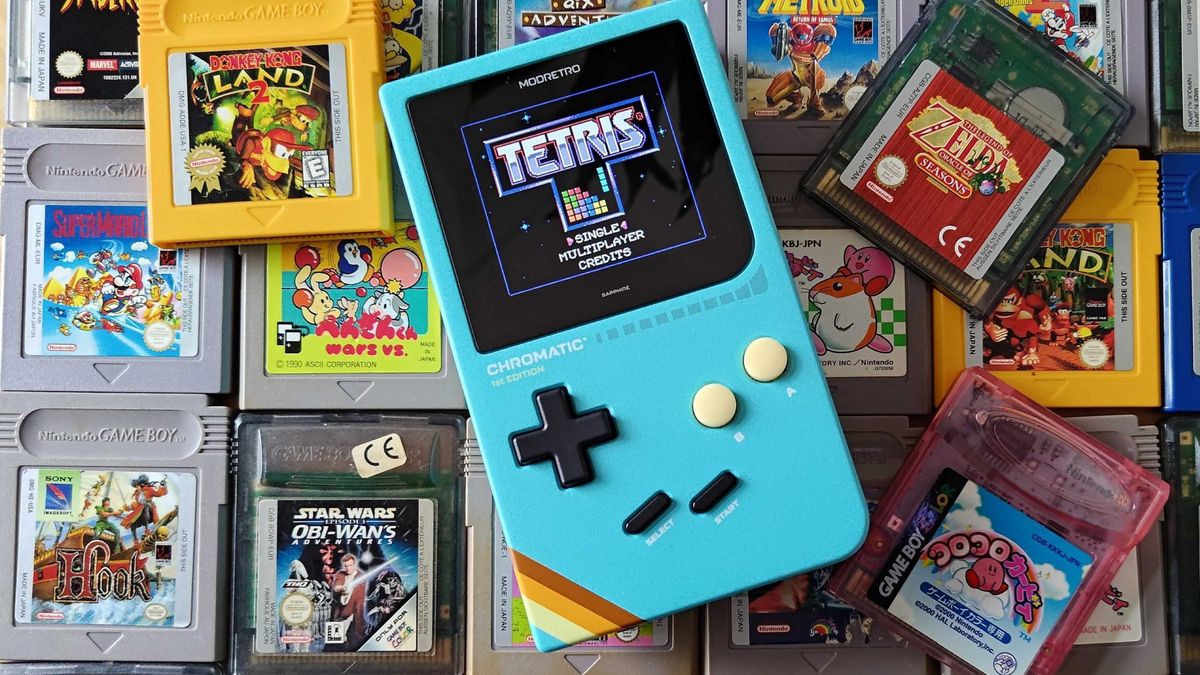12DOVE Verdict
The Modretro Chromatic is a glorious modern Game Boy Color that elevates the classic handheld using authentic FPGA tech and lavish build quality. While some players will be bummed out that it doesn’t support GBA games, and it’s still early days in terms of firmware features, this handheld homage is the perfect portable for preservationists and GBC enthusiasts alike.
Pros
- +
Incredibly authentic design
- +
Phenomenal build quality
- +
Crisp 2.56 inch IPS display
- +
Punchy speakers
- +
Full cartridge compatibility
Cons
- -
Limited to Game Boy and GBC games
Why you can trust 12DOVE
Every once in a while, a device like the Modretro Chromatic rolls along and completely changes my handheld expectations. It’s far from being the first modern take on the Game Boy I’ve tested, and I have a funny feeling it won’t be the last. But, what I will say is that it completely nails the assignment and elevates Nintendo’s ‘90s console without remotely disrupting its original vibe.
Priced at $199 / £159, the Modretro Chromatic might feel expensive, but I’d strongly argue in favor of its MSRP. Yes, it’s an investment - and it’s perhaps a lot to pay for what is functionally a Game Boy Color. Know what else can set you back most of that asking price? An original Game Boy Color. That’s before you even get to modding it with a screen you can use without sitting on the face of the sun or cleaning it up so it doesn’t feel like 26-year-old hardware.
Of course, if you’ve ever looked up the best gaming handheld for playing your old GBC cartridges, you’ve likely stumbled upon consoles like the Analogue Pocket. That $219 gadget is the Chromatic’s main rival, but many of you out there will also be eyeing up cheaper emulation-based options like the Anbernic RG35XX Plus or even the Anbernic RG Cube. I’d argue that if you’re looking for a truly authentic experience that doesn’t involve picking up a real Game Boy, Modretro’s newcomer trumps all of those fierce competitors by way of thoughtful design and clear vision.
Features
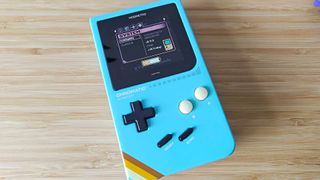
To fully lay out why I think the Modretro handheld might be the best modern Gameboy on the market, it’s worth explaining its fascinating innards. Any enthusiast readers out there will already be aware of this, but the Chromatic uses field-programmable gate array (FPGA) tech to exactly mimic Nintendo’s OG console on a hardware level. It’s still technically emulation, but rather than running ROMs through an emulator, you’re instead using circuitry? that acts precisely like every component inside Ninty’s portable.
The result? Well, as far as your Game Boy cartridge collection is concerned, you’re using a real console. That in theory means you’ll encounter no compatibility issues across the handheld’s vast library of outings – something that can’t be said for emulation devices. This is perhaps a spoiler, but I’ve yet to plug in a cart that doesn’t spring to life exactly like it does on my GBC, so you won’t find me bringing up any speed issues or weird audio complaints.
To match the replicated hardware inside, Modretro has also armed the Chromatic with a 160 x 144 IPS display with a 10:9 aspect ratio. In this instance, opting for such a low-resolution display is actually a complete boon, as it means it exactly matches the old GBC’s non-backlit TFT screen. Effectively, you’re getting pixel-perfect accuracy paired with a bright screen, and as someone who’s tested every way to play Game Boy Color games, I’m captivated by the visuals at hand.
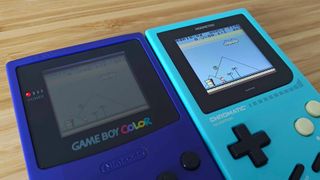
A common complaint I often hear from the retro community is that the gaming scene often misrepresents sprite art. By that, I mean modern takes in indie games sometimes blur graphics together as if it’s a deliberate aesthetic, not fully realizing that larger pixels and scanlines are fundamental parts of the graphics themselves.
For example, if I take The Legend of Zelda: Oracle of Seasons and play it on a modern gaming monitor, Link’s epic horseback opening will look blocky. Put that same intro on the Chromatic’s low-resolution screen and it ends up more like the developers originally intended, appearing almost sharper. There are better examples of this out there, but the point is that Chromatic’s screen will portray visuals as originally intended. Modretro has even matched the color temperature of its display outside of standard RGB so that it feels right, which I have to say, really feels like a step I would have never considered.

Modretro Chromatic running Zelda: Oracle of Seasons

Game Boy Color with AMOLED mod running Zelda: Oracle of Seasons

Unmodded Game Boy Color running Zelda: Oracle of Seasons
Accompanying the Chromatic’s beautiful lo-fi visuals is an incredibly loud speaker that puts my GBC to shame. To cut my trusty old console some slack, it’s suffering from low volume tied to aging components, but that only further highlights why being able to pick up a replica with booming sound in 2024 is a fantastic thing. I’ve started noticing bass harmonies in games that I’m not entirely sure I knew existed, which honestly left me feeling like I’d missed out on some wonderful 8-bit compositions over the years.
Moving onto software, and there’s not too much to talk about right now. The LCD screen’s natural pixel effect means that the onboard software has no need for overlays and effects. That’s not to say additional options won’t come to the handheld at a later date, as it is still early days for the Chromatic’s firmware. But, I actually quite like how streamlined the device’s OSD menu currently is, consisting of mainly just settings for brightness, frame blending, video output color correction, and a toggle to force player selection for relevant games.
Display: 2.56-inch 160 x 144 IPS
Shell: Magnesium alloy thixomolded
Buttons: PBT
Compatibilty: Game Boy and Game Boy Color (FPGA)
Power: 3 x AA/rechargable pack
Ports: USB-C, Link cable, IR receiver
Size: 5.2 x 3 x 1.2 inch
Weight: 0.38lbs
Yes, I did just say video output, as the Chromatic can stream gameplay via its USB-C port to your PC. That’s a neat addition for streamers or even just those of you who fancy playing on a bigger screen. At the same time, I love that including fancy USB-C connectivity didn’t stop Modretro from making the handheld’s default power delivery method good old AA batteries, instead making a rechargeable battery pack an optional extra. The decision is very in keeping with preserving the original format of the GBC, and while I did find it funny that it uses three cells instead of two, I’ve no personal gripes with this setup.
Additional extras are, as you might have guessed, all in line with the original Game Boy Color. You’ve got an IR sensor at the top and a link cable port for connecting to other consoles. That’s right, you can use this baby to trade Pokemon with your friends just like you would have back in 1998. I would go wander through my old hometown and see if anyone’s still around to battle, but I think they all have grown-up jobs and families and stuff? Sounds lame if you ask me.
Okay, let me address one Elephant Mario in the room before I get ahead of myself – the Chromatic doesn’t support Game Boy Advance games. Naturally, that’s a huge reason to pick up the Analogue Pocket or even emulate using the Anbernic RG35XXSP if you’re really into the GBA. I’ve thought long and hard about whether I believe this to be a con, and honestly? I think focusing on just Game Boy Color Functionality makes more sense, something that’ll hopefully become clear as we delve further into the handheld.
Design



Prior to getting my hands on a Chromatic, I admittedly raised an eyebrow at Modretro’s Palmer Luckey describing the device as “Heirloom-grade tribute art.” Now that I’ve spent a significant amount of time using the console, I can confirm it boasts the build quality and craftsmanship to back that bold statement up, and I can see this device outlasting all of my other handhelds.
Starting with the shell, we're talking about magnesium alloy with incredibly smooth edges and a flawless paint job. I’m always slightly wary of companies going with metal since it’s occasionally used to provide a faux-premium feel. That’s absolutely not the case with the Chromatic, and holding the handheld and running my fingers over it to feel for any molding or alignment issues instead brought me undiluted sensory joy.
That same satisfaction extends to the D-pad and buttons, which feel far more tactile than my original units. Before you accuse me of blasphemy, I do have one in the box that has barely been played, and even that console feels mushy in comparison. I’m also a huge fan of the texture choices used here too, with the face buttons featuring the same glossy smoothness as the DMG Game Boy and the D-pad using a grippy roughness. I’d go as far as to say the latter is one of the best directional pads I’ve ever used (meet me in the car park if you want to argue about that, I’m willing.)


I fully believe that the Chromatic’s elevated controls are only possible because it is free from GBA compromise. If you look at the Analogue Pocket, the spirit of the GBC is somewhat lost since it has four face buttons, and they’re smaller to fit better on the front. I’m not necessarily saying Modretro’s device would have suffered with extra inputs and shoulders on the back, but I think it’d struggle to maintain the same Game Boy Color experience.
Circling back to durability – Modretro has learned from the GBC’s sins by giving it a Sapphire Crystal lens. I wouldn’t normally give points to a handheld for using glass in the modern age, but going that step further means you’re unlikely to find the screen in the same state as many OG Game Boys in 2024. I’m fairly confident that if I handed this to any of my young family members, the display wouldn’t immediately end up all scratched, unlike many of Ninty’s handhelds I’ve restored over the years.
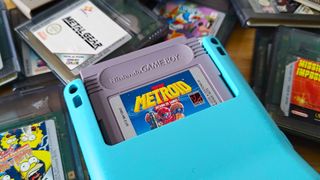
Round the back, you’ll find the cartridge slot caved out at the top. Inserting carts of all shapes and sizes results in a reassuring click, and removing them is equally as smooth. One touch I do quite like is that you can see more of your chosen game’s label since there’s a larger cutaway, so you’ll know which game you have in at a glance. Just don’t get your hopes up for secret GBA game support being in the pipeline, as the stubby carts won’t remotely fit in the slot.
Directly underneath you’ve got the battery compartment hidden under a flush cover. It pops off with a push toggle and won’t easily dislodge when in the presence of tiny hands (although I’d still supervise young players using anything with removable parts.) The inside features a plastic holster where your AA cells or rechargeable pack will fit, and while I’m not sure if it’s a deliberate design choice, it looks like it’s a bit better sealed off in the instance of any battery leakage. I’ve had to nurse too many GBCs back to health that have fallen victim to leaky bats, so I’d like to think I’ll have an easier time of it if both me and the Chromatic make it to the year 2054.
Performance
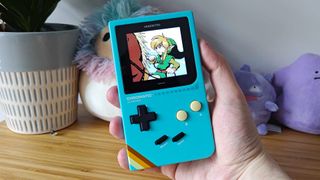
Sitting surrounded by a circle of Game Boy cartridges like I’m trying to summon some sort of 8-bit demon, I slowly but surely tried my entire collection of games out on the Chromatic. My tea box full of carts is admittedly modest but diverse enough to put Modretro’s FPGA compatibility to the test. You technically won’t even have to find dusty old adventures since the handheld comes with a new release of Tetris, but the last thing you want is to find out your favorite outing doesn’t work.
As I already touched on, I’ve been revisiting many of my personal favorite capers, The Legend of Zelda: Oracle of Seasons/Ages, Donkey Kong Land 2, Kirby’s Dreamland, and Pokemon Blue just to name a few. My most recent point of comparative reference is my AMOLED touchscreen-modded Game Boy Color, so it’s safe to say the Chromatic has a fight on its hands. I’ve also got an old clone “GB Boy Colour” console to hand that served as an effective way to play carts with an illuminated screen a decade ago, as I figured it’d be fun to see how far our options have come.
Please don’t judge me for saying the phrase “pictures say a thousand words,” but in this instance, they do a better job of portraying the evolution of the Game Boy Color. At one point, I thought the GB Boy Colour with its horribly squashed aspect ratio and atrocious viewing angles was a decent method of play, and to give myself some credit, those caveats were easier to deal with than the unlit original. Rather than being a straight linage, I do think I’m still a sucker for the vibrancy of the AMOLED GBC, but the fact a console recreation is rivaling the original this hard is the best compliment I can give the Chromatic.


The neat thing about comparing a fancy AMOLED screen to the Chromatic’s low-res LCD is that you can see exactly what Modretro is going for. The slightly less saturated colors might feel a little less vibrant, but the choice of pallet played in the authentic vibe of the handheld. Comparing the visuals to the gloomy OG console’s screen is tricky, but the FPGA system is a closer match. Plus, the larger pixels add great definition without harming brightness, whereas my modded GBC is noticeably darker with scanlines applied.
On that note, the Chromatic is bright enough to cut through natural light and well-lit rooms. Unfortunately, it’s both November and I live in Scotland, meaning direct sunlight tests aren’t really possible right now without jumping on a plane. Using artificial sources, I was able to get a good feel for how it’d fair outside on a glorious day, and let’s just say I’ll be taking this portable pal to the beach when I get the chance.
In addition to my usual haunts, I picked out two games that make for an excellent compatibility test – Perfect Dark and Kirby’s Tilt ‘n’ Tumble. Rare’s shooter features a built-in rumble motor that sets off when you’re hit, and the pink puffball uses gyro to move around in the latter adventure. I’m thrilled to say that both work, but I did notice that Kirby was verging to the right in my saved games.


I reached out to Modretro about this and they confirmed they’ve been playing the puzzle game without any issues, and I couldn’t replicate the issue in the options menu’s test screen. I’ll let you know if I get to the bottom of it, but I suspect this is an isolated incident rather than a widespread compatibility dilemma. This isn’t the first time I’ve had weird issues with specific cart and hardware pairings, and that includes using official Nintendo gear.
On the software side of things, all of the Chromatic’s bells and whistles worked without a hitch. If you prefer the monochrome visuals of the OG Game Boy or specific shades, you can swap pallets using hotkeys. Everything works exactly as it should, including the quick brightness options activated by pressing the side menu button alongside left and right. The one omission that many of you will likely miss is the lack of save-state functionality, but I do think the device’s firmware will gradually evolve with new features as time goes on.
As for battery life, I got around six hours out of a set of three AA batteries with intermittent use. I completely get why using disposable cells would be a turn-off for some people, as I still get annoyed at Xbox controllers not having built-in packs. However, I am a huge advocate for repairability, and maintaining a swappable and access power method means you’ll always have a way to give this console some juice, especially if USB-C is replaced by a new-fangled cable in the future.
Should you buy the Modretro Chromatic?
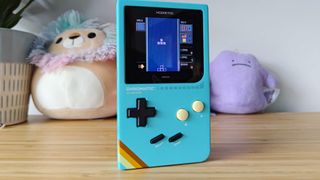
It’s safe to say that the Modretro Chromatic is a phenomenal first attempt at recreating the Game Boy Color, and I can’t remember the last time I was this excited to see more from a company. My hope is that this handheld will be the one that sparks widespread FPGA usage across various portable devices in the future, in turn making it easier to play old games without any emulation faff.
At the same time, I don’t think the Chromatic is going to harm the success of consoles like the Pocket, nor do I think that’s Modretro’s master plan. Players who are into the idea of using various FPGA handheld cores on one universal device will still want to look into Analogue’s device, and it’s safe to say software emulation will still appeal to anyone wanting quick digital access. But, I’m holding out for many more hardware recreations like this in the future, especially if they boast the same level of build quality and beauty as the Chromatic.
How I tested the Modretro Chromatic
For a week, I used the Modretro Chromatic in place of my original Game Boy Color to play my cartridges. During my testing sessions, I carefully examined the handheld’s build quality, software capabilities, and compatibility compared to the original hardware, as well as how it holds up in terms of audio and visual quality.
For more information on how we test retro gadgets and other tech, swing by our full 12DOVE hardware policy.

I’ve been messing around with PCs, video game consoles, and tech since before I could speak. Don’t get me wrong, I kickstarted my relationship with technology by jamming a Hot Wheels double-decker bus into my parent’s VCR, but we all have to start somewhere. I even somehow managed to become a walking, talking buyer’s guide at my teenage supermarket job, which helped me accept my career fate. So, rather than try to realise my musician dreams, or see out my University degree, I started running my own retro pop culture site and writing about video games and tech for the likes of TechRadar, The Daily Star, and the BBC before eventually ending up with a job covering graphics card shenanigans at PCGamesN. Now, I’m your friendly neighbourhood Hardware Editor at GamesRadar, and it’s my job to make sure you can kick butt in all your favourite games using the best gaming hardware, whether you’re a sucker for handhelds like the Steam Deck and Nintendo Switch or a hardcore gaming PC enthusiast.
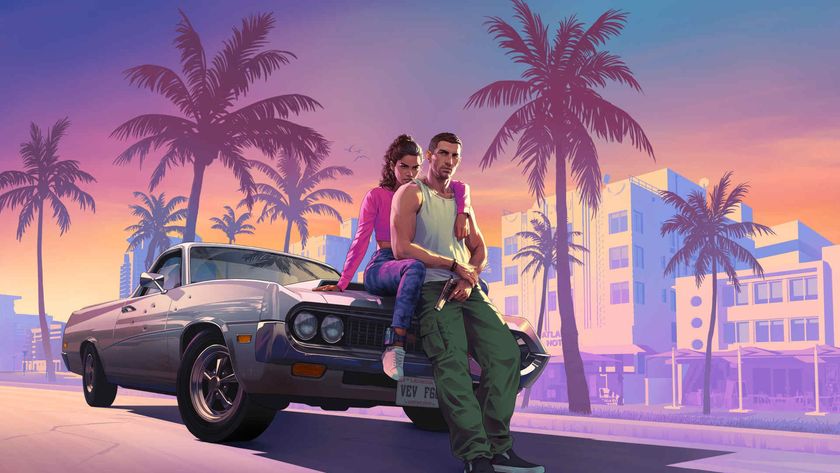
Ahead of GTA 6, Take-Two CEO says he’s “not worried about AI creating hits” because it’s built on recycled data: “Big hits […] need to be created out of thin air”

Getting Over It creator Bennett Foddy threatens the world once again: If you want Baby Steps to be a brutal rage game, "you can inflict that on yourself"

A Simpsons Hit and Run Remake will probably never happen – and I don't want it to

